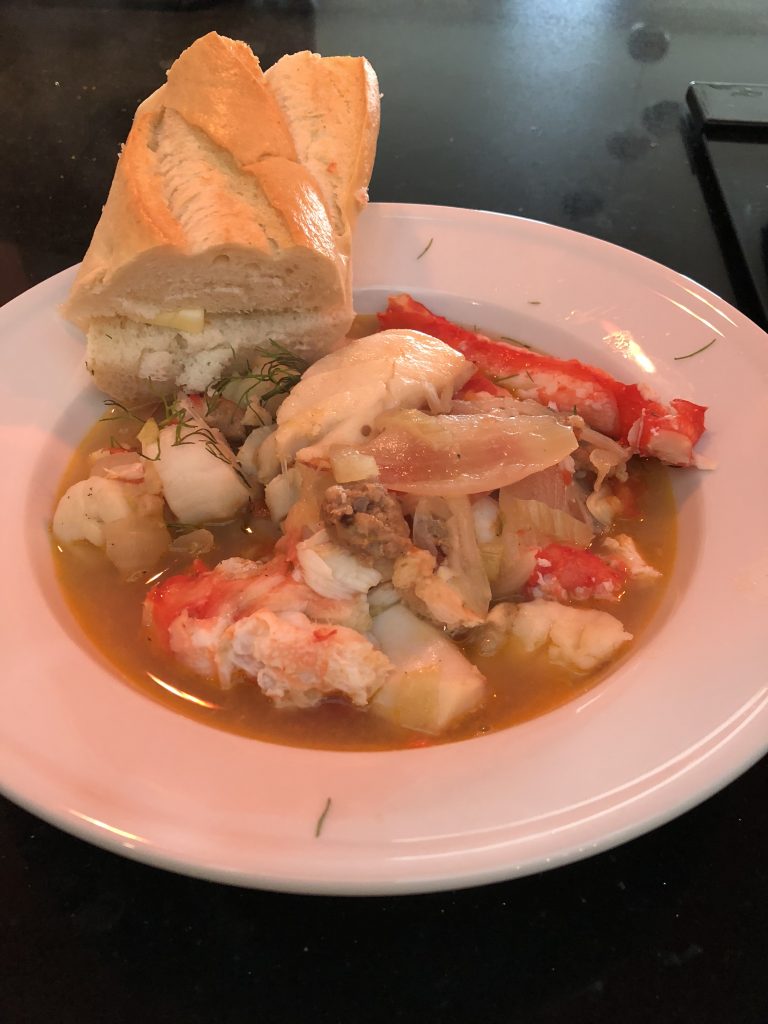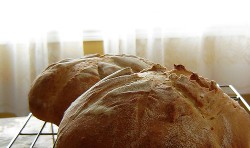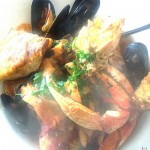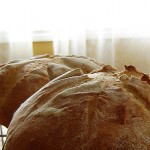

There are a variety of fishermen soups out there. I think every country has one. But I gotta tell you that I love Cioppino the best. I think that there is something good and humble about it, and yet it’s so full of flavor that you really only some good bread to eat it with.
Historically, this is made with the left over fish from the say after the fishermen sold their products and had some stuff left. It wasn’t made with the pretty fish and seafood we use today. But I bet it was still packed with flavor and briny goodness. I’m a little bougie. If you can’t tell, there are some king crab legs in my soup. Not because I’m showing off, but because that was the crab I had in my freezer.
Every year, my dad sends me king crab legs on my birthday. It’s been a tradition for a while. He hasn’t been able to get into town for the last couple of years due to health. So I haven’t been able to eat any king crab unless I make the trek up to Alaska. Looking at this soup, it is well worth it.
CIOPPINO
- 2 tablespoons good olive oil
- Shrimp and shells from 1 pound large shrimp
- 2 cups chopped yellow onion (2 onions)
- 2 fennel heads, keep some fronds for garnish
- 2 carrots, unpeeled and chopped
- 3 celery stalks, chopped
- 2 garlic cloves, minced
- 1 tsp fennel seeds
- crushed red pepper flakes
- 1 can San Marzano tomatoes
- 4 cups seafood stock, recipe below or buy from store
- 1/2 cup dry white wine
- 1/3 cup tomato paste
- 10 sprigs fresh thyme
- Diamond Kosher salt and freshly ground black pepper
- 1 1/2 pounds center-cut cod fillets, skin removed, 2-inch diced
- 1 pound sea scallops, halved crosswise
- 24 mussels, scrubbed
- 1 pound crab
- 1 tablespoon Anise flavored liquor
- 3 tablespoons minced fresh parsley
Seafood Stock:
- 2 tablespoons good olive oil
- Shells from 1 pound large shrimp
- 2 cups chopped yellow onion (2 onions)
- 2 carrots, unpeeled and chopped
- 3 celery stalks, chopped
- 2 garlic cloves, minced
- 1/2 cup dry white wine
- 1/3 cup tomato paste
- 10 sprigs fresh thyme
- Kosher salt and freshly ground black pepper
Garlic Toasts:
- 1 baguette
- 1/4 cup good olive oil
- Kosher salt and freshly ground black pepper
- 1 garlic clove, halved lengthwise
Instructions:
- Heat 1/4 cup olive oil in a large Dutch oven over medium heat. Add the fennel and onion and saute for 10 minutes, until tender. Stir in the garlic, fennel seeds, and red pepper flakes and cook for 2 minutes, until fragrant. Then add the tomatoes, stock, wine, 1 tablespoon salt, and 1 teaspoon black pepper. Bring to a boil, lower the heat, and simmer uncovered for 30 minutes. The stock will be highly seasoned.
- Add the seafood in the following order: first the cod, then the shrimp, scallops, and finally the mussels. Do not stir! Bring to a simmer, lower the heat, cover, and cook for 8 to 10 minutes, until all the seafood is cooked and the mussels are open. Stir in the liquor, cover and set aside for several minutes for the flavors to blend. Discard any mussels that have not opened. Ladle into large shallow bowls, sprinkle with parsley and fennel fronds. Serve hot with toasted garlic bread.
Seafood Stock:
- Warm the oil in a medium pot set over medium heat. Add the shrimp shells, onions, carrots, and celery and cook for 15 minutes, until the vegetables are lightly browned and the shrimp shells have turned completely pink. Add the garlic and cook for one more minute. Add 1 1/2 quarts water, the wine, tomato paste, thyme, 1 tablespoon salt, and 1 1/2 teaspoons pepper. Bring to a boil, lower the heat, and simmer for one hour. Strain through a sieve, pressing on the solids. You should have approximately 1 quart of stock. If not, add enough water or white wine to make 1 quart.
- Cool completely, transfer to containers, and refrigerate for up to 3 days or freeze for up to 1 month.
Garlic Toasts:
- Preheat the oven to 400 degrees F.
- Slice the baguette diagonally in 1/4-inch-thick slices.
- Lay the slices in one layer on a sheet pan, brush each with olive oil, and sprinkle generously with salt and pepper. Bake for 15 to 20 minutes, until browned and crisp. As soon as they’re cool enough to handle, rub the top of the toasts with a cut side of the garlic. Serve at room temperature.













